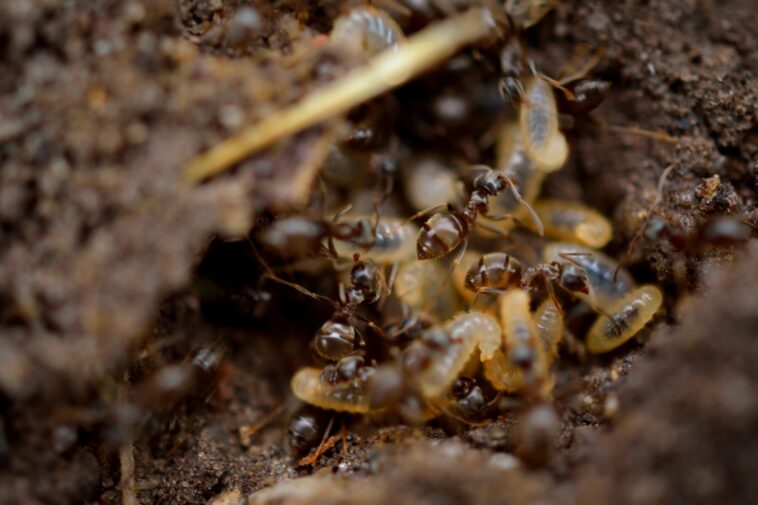Discovering termites in your home can be a homeowner’s worst nightmare. These tiny pests can cause serious damage to the structure of your house if left unchecked. But don’t panic! Getting rid of termites is possible with the right knowledge and approach. This guide will walk you through the steps you can take to identify, treat, and prevent termite infestations.
Identifying Termite Infestation
Before you can tackle a termite problem, you need to know you have one. Termites are sneaky and often work behind the scenes, making early detection crucial. Here are some signs to look out for:
- Mud Tubes: These are small, pencil-sized tubes that termites build to travel between their colony and their food source (your house!). Look for them along foundation walls, in crawl spaces, and near wooden structures.
- Damaged Wood: Tap on wooden surfaces. If they sound hollow or crumble easily, termites might be munching away inside. You might also see blisters or sunken areas on wood surfaces.
- Frass (Termite Droppings): Drywood termites leave behind small, pellet-like droppings called frass. These are often found near termite entry points.
- Swarming Termites: These are winged termites that emerge from their colony to mate and start new colonies. If you see swarms of winged insects, especially in the spring, it’s a strong indicator of a termite problem. They often are attracted to light and may be seen near windows and doors.
- Sagging Floors or Ceilings: In severe infestations, termites can weaken the structural timbers of your home, leading to sagging floors or ceilings.
Termite Treatment Options
Once you’ve confirmed you have termites, it’s time to take action. Several treatment options are available, each with its pros and cons. The best approach depends on the type of termite, the extent of the infestation, and your budget.
DIY Termite Treatments
For minor infestations, you might consider DIY treatments. These are generally more effective for drywood termites than subterranean termites, which have larger and more complex colonies. Keep in mind that DIY methods may not completely eliminate a large or established infestation.
- Boric Acid: Boric acid is a natural insecticide that is toxic to termites. You can apply it as a dust to termite galleries or use it to treat wood surfaces.
- Orange Oil: Extracted from orange peels, orange oil contains d-limonene, which is toxic to termites. It can be injected directly into termite galleries.
- Diatomaceous Earth (DE): This is a natural powder made from fossilized algae. It’s abrasive and dehydrates termites, eventually killing them. Apply it around areas where you suspect termite activity. Make sure to use food-grade DE, as other types can be harmful to humans and pets.
Professional Termite Control
For serious infestations, or if you’re uncomfortable handling chemicals yourself, it’s best to call in the professionals. Pest control companies have the expertise and tools to effectively eliminate termites and prevent future infestations.
- Liquid Termiticides: These are chemicals that are applied to the soil around your home to create a barrier that termites cannot cross. Termites that come into contact with the termiticide will die. Common liquid termiticides include Termidor (fipronil) and Premise (imidacloprid).
- Termite Baits: Termite baits consist of cellulose (wood) laced with a slow-acting poison. Termites feed on the bait and carry it back to their colony, eventually killing the entire colony. Bait systems are typically installed in the ground around your home.
- Fumigation: This is a drastic measure used for severe infestations. It involves sealing the entire house and filling it with a fumigant gas that kills all the termites inside. Fumigation is effective but requires you to leave your home for several days and can be expensive.
When choosing a pest control company, get quotes from multiple companies and ask about their experience, treatment methods, and warranties. Make sure they are licensed and insured.
Preventing Termite Infestations
Prevention is key to avoiding future termite problems. Here are some steps you can take to make your home less attractive to termites:
- Eliminate Moisture: Termites thrive in damp environments. Fix leaky pipes, clear clogged gutters, and ensure proper drainage around your foundation.
- Remove Wood Debris: Remove any wood scraps, firewood, or mulch that is in contact with your foundation. Store firewood away from your house and elevate it off the ground.
- Maintain a Barrier Between Soil and Wood: Ensure there is at least 6 inches of clearance between the soil and any wooden parts of your house, such as siding and door frames.
- Regular Inspections: Schedule regular termite inspections by a qualified pest control professional. Early detection can save you a lot of money and stress in the long run.
- Use Treated Wood: When building or remodeling, use pressure-treated wood that is resistant to termite damage.
Safety Tips
When dealing with termites, whether through DIY treatments or professional services, safety should be your top priority.
- Always read and follow the instructions on any insecticide label carefully.
- Wear appropriate protective gear, such as gloves, masks, and eye protection, when handling chemicals.
- Keep children and pets away from treated areas until they are completely dry.
- If you experience any adverse reactions to insecticides, seek medical attention immediately.
Frequently Asked Questions
How much does termite treatment cost?
The cost of termite treatment can vary widely depending on the size of your home, the extent of the infestation, and the treatment method used. DIY treatments can cost as little as $20, while professional treatments can range from a few hundred dollars to several thousand dollars. Fumigation is typically the most expensive option.
How long does termite treatment last?
The longevity of termite treatment depends on the method used. Liquid termiticides can provide protection for several years, while bait systems require ongoing maintenance and monitoring. Regular inspections are essential to ensure that the treatment remains effective.
Are termites covered by homeowner’s insurance?
Unfortunately, termite damage is typically not covered by homeowner’s insurance. This is because termite infestations are considered preventable through regular maintenance and inspections.
Can I treat termites myself, or should I hire a professional?
For minor, localized infestations, DIY treatments may be effective. However, for larger or more complex infestations, it is best to hire a professional pest control company. Professionals have the expertise, tools, and access to more effective treatments.
Dealing with termites can be frustrating, but by understanding the signs of infestation, treatment options, and prevention strategies, you can protect your home from these destructive pests. Remember to act quickly if you suspect a termite problem and don’t hesitate to seek professional help when needed. Your home is a valuable investment, and protecting it from termites is essential for your peace of mind and financial security.



GIPHY App Key not set. Please check settings